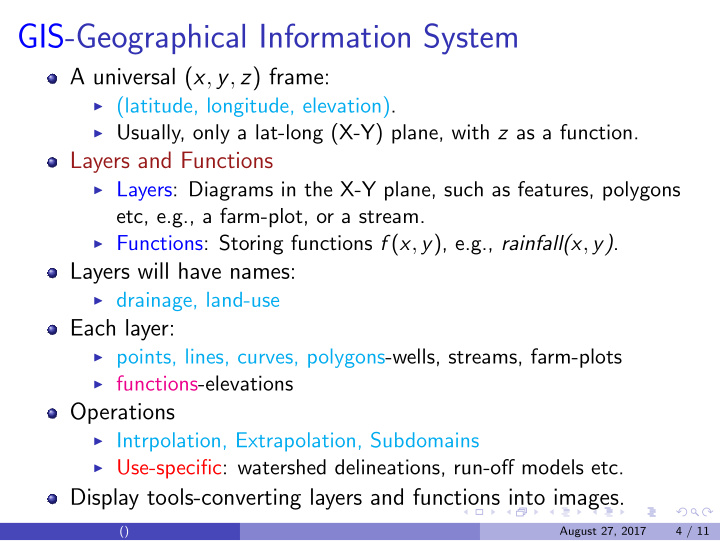



GIS-Geographical Information System A universal ( x , y , z ) frame: ◮ (latitude, longitude, elevation). ◮ Usually, only a lat-long (X-Y) plane, with z as a function. Layers and Functions ◮ Layers: Diagrams in the X-Y plane, such as features, polygons etc, e.g., a farm-plot, or a stream. ◮ Functions: Storing functions f ( x , y ), e.g., rainfall(x , y) . Layers will have names: ◮ drainage, land-use Each layer: ◮ points, lines, curves, polygons-wells, streams, farm-plots ◮ functions-elevations Operations ◮ Intrpolation, Extrapolation, Subdomains ◮ Use-specific: watershed delineations, run-off models etc. Display tools-converting layers and functions into images. () August 27, 2017 4 / 11
Papagni Watershed The Papagni river water shed is about 2500 sq. km, in a border district of Andhra Pradesh. It is one of the study areas of the Foundation for Ecological Security (www.fes.org.in). The following maps are from FES. The physical map- The toposheet. The Drainage-outlines all streams and rivers in the water shed. The sub-water shed map-outline all sub-domains down to micro-watersheds, which are about 3-10 sq. km. The next two are the geological data sheets. Next, we have the land use data. Finally we have the development-potential. This is a basic input for any development plan. Question-Static Data What goes into the collection of such data and its representation? () August 27, 2017 5 / 11
The Papagni maps 1:250,000 maps of a particular district/valley in A.P. These cover various attributes related to ground and surface water. Water related: Drainage, Digital terrain Map (DTM), Micro-watershed, Geology, Landscape, Land-Use/Cover, Groundwater potential, Sub-watershed priority. Ancillary: Soil erosion, Risk of Fire. Development related: Composite Land Development Unit. Scales: Scale 1m 1 Hectare (in mm.) Typical use 1:250,000 250 km < 1sq. mm District 1:50,000 50 km 2 × 2 Taluka 1:5,000 5 km 20 × 20 Gram-Panchayat () August 27, 2017 6 / 11
Legends Drainage, DTM obvious and so is the micro-water shed map. What is the data required and how is it obtained? ◮ DTM is the base map which is remote-sensed (How?). ◮ Watersheds are outlined through an auotomatic delineation. ◮ Drainage: ◮ Towns, villages, roads, political boundaries: a GIS layer. Geological:This is about the origins of soil/rock of the area. It is also typically, what lies below the regalith , i.e., unconsolidated overlying material. ◮ Crystalline: substrate rock, typically crystalline, in this case, gneiss and granite. ◮ Intrusive: that which intrudes from beneath the crystalline base rock. Usually a dike (planar fault) or pipes (tubular fault), or because of a different rock-type, in this case quartz. ◮ Residual: The parent rock. () August 27, 2017 7 / 11
More Legends Geomorphological/Landscape: The shape rather than the origin. Structural hill: Largely uneroded outcrops. Denudational hill: Weathered hills. Pediment: roughly planar rock, with or without a thin layer of soil. Typically between hills. Pediplain: A tapestry of pediments. Pediment-Inselberg: A hill outcrop from a pediment. Piedmont: Plains at the base of hills formed by stream deposits. Papagni: largely structural hills and pediplains. Land Use/Cover: Agricultural (season,fallow), Forest, Waste. Papagni: Largely kharif, fallow. Forests on the hill-slopes. Also note the correlation with the geo-morphology. Groundwater Potential: seems correlated with dikes and drainages. Generally poor. Erosion: seems correlated with the slope-map . Finally, Land Dev. Unit : Prescriptions, largely water interventions. () August 27, 2017 8 / 11
Typography of data Name Type Means of gathering Elevation Scientific Satellite, Surveying Geology Scientific Surveys, bore-logs Rainfall etc. Climatological weather stations Drainage Intermediate Surveys, Mathematics Infiltration Intermediate mathematical Land Use Socio-economic talathi , satellite Cropping pattern Socio-economic Agriculture Census, roads administrative various departments Household compensation policy composite Development Priority planning composite () August 27, 2017 9 / 11
Maps The main national source of maps are: Survey of India, Geological Survey of India for 1:250,000 standard data and geology. http://www.lib.utexas.edu/maps/ams/india/ US army series U502 again 1:250,000. National Remote Sensing Center () August 27, 2017 10 / 11
Recommend
More recommend